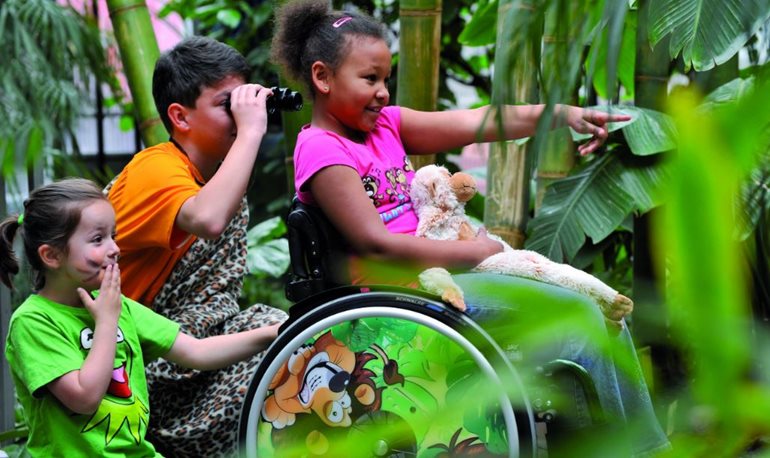Share:
Take it offline!
This Education in Motion resource is also available as a printable PDF.
Download PDF
Whether it’s through structured activities or recreation, play is an essential part of a child’s physical and mental development. Incorporating play into your child’s life will provide a strong developmental foundation, helping refine motor skills and improve their general learning experience. For children with disabilities, it’s doubly important that you are giving your son or daughter the most beneficial playtime resources that match their needs. Adapted toys are one of the most effective playtime tools, helping your child build their self-esteem and improve their physical capabilities.
The History of Adapted Toys
After years of studying the role of playtime and its impact on children, there is a widely acknowledged consensus that play is a fundamental part of early development. By 1959, even the United Nations General Assembly understood the importance of play, recognising it as an inalienable right of the child. Through playtime, children are exposed to the outside world, facilitating the growth of introspective and interpersonal skills.
However, despite the importance of play, many children with disabilities are not able to access the right toys or resources, hampering their development and learning. Adapted toys help children with disabilities reach their potential, ensuring that they are given the same opportunities as every other child. Similarly, the design and manufacturing of adapted toys is a symbolic show of support for accessible communities.
What Constitutes an Adapted Toy?
Broadly speaking, adapted toys are regular toys that have been modified to make them accessible and useful to children with disabilities. The physical modifications range from simple changes, like adding Velcro straps to a figurine, or more complicated, such as reformatting visual and multimedia effects to create adapted educational toys. Children with lower levels of motor skills cannot use regular battery operated toys but they can use adapted Switch operated toys.
It is difficult to establish specific guidelines for the design and manufacture of adapted toys because of the diverse number of physical and mental disabilities. However, this general framework, based on four key points, is a useful guide on adapted toys:
Fair design choices
Each toy should be designed under the assumption that it will work for everyone. Operating under this principle ensures that any differences between adapted and non-adapted toys are minimal.
Versatility
Expanding the toys uses means that it can be easily adapted to suit the needs of any child.
Flexibility
A broad range of toys, with varying degree of complexity, gives children the choice to play with a toy that is in line with their learning abilities.
Safety
The design and manufacture of adapted toys must be carried out in compliance with stringent safety guidelines.

The Different Types of Adapted Toys
A wide variety of adapted toys have been developed for different types of play. Some of the most common adapted toys include:
Exercise toys
Physical toys that are designed to encourage repetitive actions or movements.
Symbolic toys
The primary function of these toys is to stimulate your child’s imagination during play.
Building toys
A physical toy that is commonly used to develop fine motor skills and improve hand-eye coordination.
Cause and Effect Toys
These usually have a switch that once pressed results in an effect such as noise or light.
Rule-based games
These games (cards, board games etc.) are built around a set of ideas and guidelines, introducing children to cooperative play and rules-based fun.
Educational games
A great combination of entertaining play and interactive education (flash cards, quizzes etc.).
Adapted Toys and Your Child
It’s important to remember to choose an adapted toy that relates to your child’s interests. These could include but are not limited to sport, music, art, dolls, cars, animals and various kids movies. Choosing toys that appeal to their interests means that they’ll be more likely to play and engage with their toy. The use of adapted toys provides various benefits including improving strength, increasing a child’s understanding of cause and effect, improving motor skills as well for general enjoyment and fun.
Adaptations for Physical, Visual and Auditory Disabilities
A different series of adaptations are required for children with disabilities that affect their mobility or motor skills. If this is the case, the toy adaptations should be designed to mitigate the impact of the disability on physical playtime, helping children find more joy in their daily activities. Some of these adaptations include:
- Preventing toys from sliding or movement by attaching Velcro straps.
- Increasing the size of toy handles, levers, rings or other attachments, ensuring that they are easier to move and manipulate.
- If the toys are designed for dragging movements, ropes or cords can be used to facilitate easier movement.
- Changing the dimensions of the toy to make handling it easier.
If the adapted toy is meant for a child with a visual impairment, the most important adaptations include using textured surfaces and sound effects.
- Board games and card games must include Braille instructions and translations.
- Use to highlights graphs, illustrations or symbols.
- Voice recordings can be used in place of text.
If the targeted disability is a hearing impairment, adapted toys should:
- Emphasize the use of text instead of audio messages.
- Utilise transformative electronic devices to convert audio to a form of communication that the user can understand (varying vibrations etc.)
At Sunrise Medical, we have created a range of mobility products especially for children, take a look at our manual wheelchairs for children and our powered wheelchairs for children.